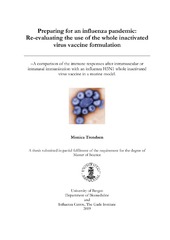Preparing for an influenza pandemic: Re-evaluating the use of the whole inactivated virus vaccine formulation. –A comparison of the immune responses after intramuscular or intranasal immunization with an influenza H5N1 whole inactivated virus vaccine in a murine model.
Master thesis
Permanent lenke
https://hdl.handle.net/1956/3539Utgivelsesdato
2009-10-22Metadata
Vis full innførselSamlinger
Sammendrag
Influenza is a highly contagious respiratory disease which infects millions of people every year around the world. Influenza viruses undergo continuous antigen change and annual vaccination is an effective prophylactic measurer to combat the disease and to reduce morbidity and mortality. Recently, viruses of avian (and swine) origin have crossed the species barrier and caused infection in man, thus highlighting the need of vaccines that induce a strong and rapid immune response in a naïve population. Inactivated intranasally administered vaccines are not currently licensed, but would provide an attractive alternative to conventional intramuscular vaccination as they have the advantage of being non-invasive, easily administered and also induces a mucosal immune response. Studies have shown that vaccines containing avian subtypes are poorly immunogenic and have lead to a re-evaluation of the use of whole virus vaccines which are more immunogenic than standard subunit vaccines and can be dose sparing. In the current study we have investigated the immune response after one or two doses of intramuscular or intranasal inactivated influenza H5N1 vaccine in BALB/c mice using whole virus vaccine containing 7.5 µg HA. Serum samples were analyzed using ELISA and HI assay, whereas lymphocytes from spleens and bone marrows were used to measure the number of antibody secreting cells (ASC) using ELISPOT. Splenic lymphocytes were stimulated in vitro and cytokine profiles were measured by multiplex bead assay. Additionally, we also measured local IgA from nasal washings by ELISA. The intramuscular vaccine route induced a strong, long lasting humoral immune response and was characterized by a Th-1 cytokine profile after one vaccine dose, and a more mixed Th-1/Th-2 profile after two doses. In contrast, the intranasal vaccine route induced a strong local immune response after two vaccine doses and a good humoral immune response as well. This group showed a dominant a Th-2 profile, but also secreted cytokines associated with a Th-1 profile (IFN-γ and IL-2) and high levels of IL-17 (Th-17). Although both vaccine routes induced high levels of serum and HI antibody, the intranasally delivered vaccine also induced local IgA which provides the first line of defence against respiratory diseases. In addition, it would be suitable for use in developing countries as it is needle-free and easy to administer. We therefore suggest that an intranasally administered whole virus vaccine would be a good candidate for further investigation of a pandemic H5N1 candidate vaccine.
Utgiver
The University of BergenOpphavsrett
Copyright the author. All rights reservedThe author
